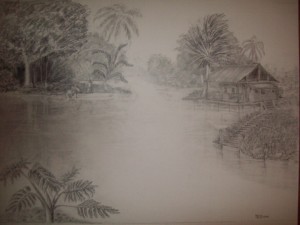
I recently posted a blog discussing the different steps I use to finish a painting. By using the steps, it often ends by producing more than one complete work of art for sale. This is the importance of making practice paintings for the final work. I will use the work (on the left) that I am presently doing to give you an example of what I mean. (If you click on the drawing, it will only take you to the blog posted to explain the drawing instead of increasing in size. All others on this page should enlarge the pictures when you click on them.)
The completed graphite drawing drawn to size (22″X30″) shown is the third of a seven step process. (One: rough sketch…two: several value sketches.) For all practical purposes, this graphite drawing can be framed and sold. I’m sure you’ve been told by every art instructor in the world, never throw anything away!
Another important step is next. That is a realistic painting in pastel or watercolor of different segments of the painting. This often will produce different completed, framed, and salable paintings; thus increasing the value of your original composition. Since the completed painting is to be a 22″X30″ watercolor, I will make smaller but full size segmented practice paintings in watercolor.
Below are three compositions taken from the drawing above that I will use for practice (and hopefully make complete paintings).
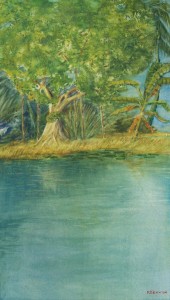
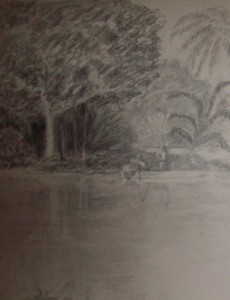
The first of the three practice paintings is complete. Compare left to right, and you will see the similarity.
The men in the boat fishing were intentionally left out of this practice painting because they will be in a painting of their own.
When I lay the painting over the drawing, It gives me an idea of how the overall painting will look.
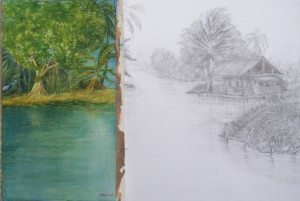
Believe me, y0u will have the opportunity to correct a lot of mistakes by making the practice paintings before you attempt the final paintings. Again, if you’re lucky, you will be able to frame and sell the practice paintings by themselves; thus, increasing your pay for work ratio.
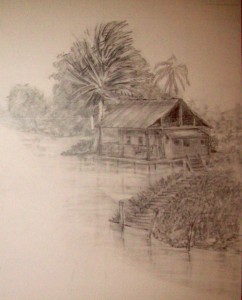
The practice painting I am presently working on is the right hand segment of the drawing. This one is so important because it will consider the entire concept of value – the foreground, mid-ground, and background. The color of the water and its reflections will have to be considered carefully, because it will have to fit into the other painting segment. However, there can be several different colors used since it is open and extending far into the background (for example, yellows and purples). With these colors (if it works), it may possibly help make the composition more appealing…we’ll see. But, then again, this is why we call it a practice painting.
So, a practice painting of a segment of the composition can help an artist work out different problems long before attempting the final work…but what’s wrong with making the whole venture a profit making venture?
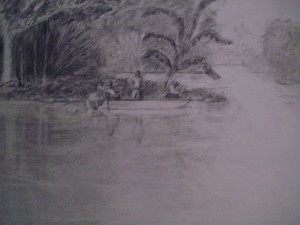
Painting number three~As you can see, this is a composition showing three men fishing from a boat. How original is that? There’s been umpteen gazillion paintings of men fishing from a boat…and I don’t care. What does it matter? When I finish this painting it will be an original R. D. Burton watercolor…and you can take that to the bank.
However, I’m using this segment for a more important purpose, not just because it will make a composition. Since the overall picture is a relatively large composition, it is important that I make a portion of the composition to be a focus point of interest. I’ve chosen this segment to do just that. However, it will be hard to do unless I impact this segment with certain colors to grasp the viewer’s attention. This will take practice. It’s in my head, but I have to get it on paper.
As you can see, the men are fishing near a bank off to the right, but in front of the banyan and beneath the banana tree. I intentionally drew a second bank with a strip of water farther behind the men. This (hopefully) will help direct the viewer’s eyes to the men. In my imagination, I can see using color to impact the area; for example, paint the banana tree with yellows, rusts (dying leafs), reds, and various shades of green. The banana tree is already directing the viewer to the men by the way it is composed (like an arrow pointing to them). Across the water behind the men there are leafy plants that can be oranges, reds, and yellow…Impact! Perhaps, the hats the men are wearing can be painted with bright colors. Or, A red strip from front to back on the brightest white in the painting…the boat. And then there is another attention grabber…the reflection of the men in the water. What will be important is carefully working out the reflections. If I do it correctly, this can capture the interest of the viewer (some may spend time studying this part just to make sure it is done properly). Again, my main purpose of the practice painting is to work out an impact area that will help entertain viewers when viewing the larger composition. We’ll see. I’ll know more after making the planned practice paintings.
Be sure to enter for our ART CENTER INFORMATION newsletter.
